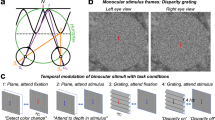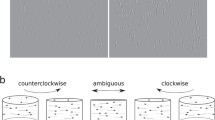Abstract
Over what region of space are horizontal disparities integrated to form the stimulus for vergence? The vergence system might be expected to respond to disparities within a small area of interest to bring them into the range of precise stereoscopic processing. However, the literature suggests that disparities are integrated over a fairly large parafoveal area. We report the results of six experiments designed to explore the spatial characteristics of the stimulus for vergence. Binocular eye movements were recorded using magnetic search coils. Each dichoptic display consisted of a central target stimulus that the subject attempted to fuse, and a competing stimulus with conflicting disparity. In some conditions the target was stationary, providing a fixation stimulus. In other conditions, the disparity of the target changed to provide a vergence-tracking stimulus. The target and competing stimulus were combined in a variety of conditions including those in which (1) a transparent textured-disc target was superimposed on a competing textured background, (2) a textured-disc target filled the centre of a competing annular background, and (3) a small target was presented within the centre of a competing annular background of various inner diameters. In some conditions the target and competing stimulus were separated in stereoscopic depth. The results are consistent with a disparity integration area with a diameter of about 5°. Stimuli beyond this integration area can drive vergence in their own right, but they do not appear to be summed or averaged with a central stimulus to form a combined disparity signal. A competing stimulus had less effect on vergence when separated from the target by a disparity pedestal. As a result, we propose that it may be more useful to think in terms of an integration volume for vergence rather than a two-dimensional retinal integration area.







Similar content being viewed by others
References
Allison RS, Howard IP, Fang X (2000). Depth selectivity of vertical fusional mechanisms. Vision Res 40:2985–2998
Anstis SM (1974) Chart demonstrating variations in acuity with retinal position. Vision Res 14:589–592
Badcock DR, Schor CM (1985) Depth–increment detection function for individual spatial channels. J Opt Soc Am A 2:1211–1215
Burian HM (1939) Fusional movements: the role of peripheral retinal stimuli. Arch Ophthalmol 21:486–491
Busettini C, Fitzgibbon EJ, Miles FA (2001) Short-latency disparity vergence in humans. J Neurophysiol 85:1129–1152
Cumming BG, Parker AJ (1999) Binocular neurons in V1 of awake monkeys are selective for absolute, not relative, disparity. J Neurosci 19:5602–5618
Edwards M, Pope DR, Schor CM (1998) Luminance contrast and spatial-frequency tuning of the transient-vergence system. Vision Res 38:705–717
Francis EL, Owens DA (1983) The accuracy of binocular vergence for peripheral stimuli. Vision Res 23:13–19
Glennerster A (1998) dmax for stereopsis and motion in random dot displays. Vision Res 38:925–934
Hampton DR, Kertesz AE (1983) Fusional vergence response to local peripheral stimulation. J Opt Soc Am 73:7–10
Howard IP, Rogers BJ (2002) Seeing in depth. Vol 2: depth perception. I. Porteous, Toronto
Howard IP, Zacher JE (1991) Human cyclovergence as a function of stimulus frequency and amplitude. Exp Brain Res 85:445–450
Howard IP, Sun L, Shen X (1994) Cycloversion and cyclovergence: the effects of the area and position of the visual display. Exp Brain Res 100:509–514
Howard IP, Fang X, Allison RS, Zacher JE (2000) Effects of stimulus size and eccentricity on horizontal and vertical vergence. Exp Brain Res 130:124–132
Hung GK, Semmlow JL, Sun L, Ciuffreda KJ (1991) Vergence control of central and peripheral disparities. Exp Neurol 113:202–211
Jones R, Stephens GL (1989). Horizontal fusional amplitudes. Invest Ophthalmol Vis Sci 30:1638–1642
Kumar T, Glaser DA (1995). Depth discrimination of a crowded line is better when it is more luminant than the lines crowding it. Vision Res 35:657–66
Mallot HA, Roll A, Arndt PA (1996) Disparity-evoked vergence is driven by interocular correlation. Vision Res 36:2925–2938.
Pope DR, Edwards M, Schor CM (1999) Orientation and luminance polarity tuning of the transient-vergence system. Vision Res 39:575–584
Popple AV, Smallman HS, Findlay JM (1998) The area of spatial integration for initial horizontal disparity vergence. Vision Res 38:319–326
Prince SJD, Cumming BG, Parker AJ (2002) Range and mechanism of horizontal disparity encoding in macaque V1. J Neurophysiol 87:209–221
Robinson DA (1963) A method of measuring eye movement using a scleral search coil in a magnetic field. IEEE Trans Biomed Eng BME 10:137–145
Sato M, Edwards M, Schor M (2001) Envelope size tuning for transient disparity vergence. Vision Res 41:1695–1707
Stevenson SB, Cormack LK, Schor CM, Tyler CW (1992) Disparity tuning in mechanisms of human stereopsis. Vision Res 32 1685–94
Stevenson SB, Lott LA, Yang J (1997) The influence of subject instruction on horizontal and vertical vergence tracking. Vision Res 37:2891–2898
Stevenson SB, Reed PE, Yang J (1999). The effect of target size and eccentricity on reflex disparity vergence. Vision Res 39:823–832
Von der Heydt R, Adorjani CS, Hänny P, Baumgartner G (1978). Disparity sensitivity and receptive field incongruity of units in the cat striate cortex. Exp Brain Res 31:523–545
Westheimer G, McKee SP (1980) Stereogram design for testing local stereopsis. Invest Ophthal Vis Sci 19:802–809
Westheimer G, Tanzman IJ (1956) Qualitative depth localization with diplopic images. J Opt Soc Am 46:116–117
Winkelman JE (1951) Peripheral fusion. Arch Ophthalmol 45:425–430
Winkelman JE (1953) Central and peripheral fusion. Arch Ophthalmol 50:179–183
Yang, DS, FitzGibbon EJ, Miles FA. (2003) Short-latency disparity-vergence eye movements in humans: sensitivity to simulated orthogonal tropias. Vision Res 43:431–443
Acknowledgements
The support of NSERC Canada to I.P. Howard and R.S. Allison is gratefully acknowledged. The authors would like to thank Jim Zacher for his technical expertise and his assistance in running the experiments.
Author information
Authors and Affiliations
Corresponding author
Rights and permissions
About this article
Cite this article
Allison, R.S., Howard, I.P. & Fang, X. The stimulus integration area for horizontal vergence. Exp Brain Res 156, 305–313 (2004). https://doi.org/10.1007/s00221-003-1790-0
Received:
Accepted:
Published:
Issue Date:
DOI: https://doi.org/10.1007/s00221-003-1790-0




